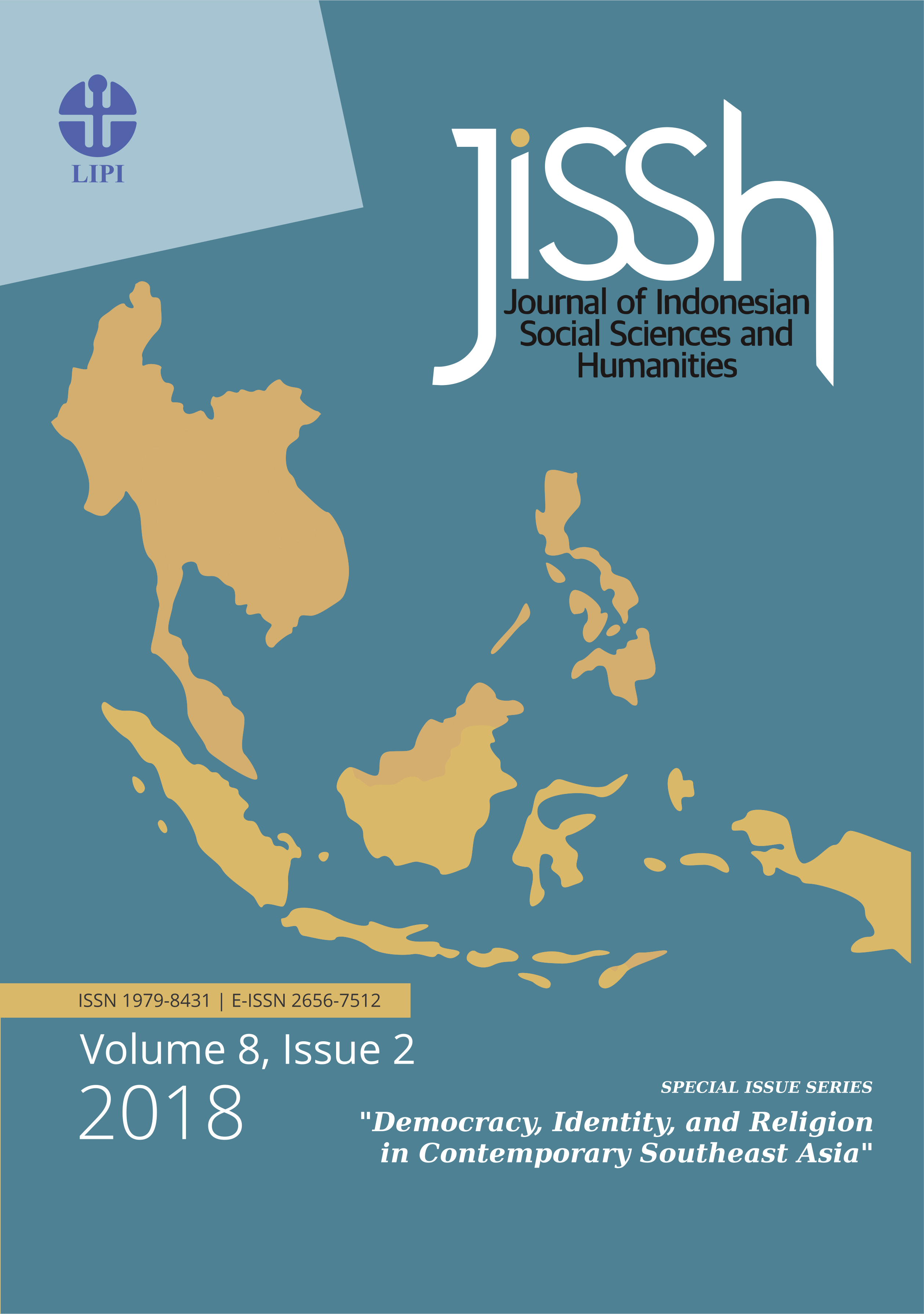Adat and Religious Tolerance: Ethnophilosophy Perspective
Keywords:
costum, adat, ethnic community, ethnophilosophy, ethnic solidarity, religious toleranceAbstract
As a country with the largest Muslim’s population in the world, Indonesia has an overwhelming number of communities with different religions, such as Protestant, Catholic, Buddhist, Hindu, Confucianism and other local religions from ancestors that influence various Indonesian people’s beliefs. This situation can raise the tendency of conflicts between the majority groups of certain religions and other minority religions in Indonesia. This paper aims to explore the conditions of ethnic communities in Alor District, East Nusa Tenggara Province, who live harmoniously among different religions such as Muslims and Christians. Alor District has obtained a trophy of ‘Harmony Award’ 2017 from the Ministry of Religion of the Republic of Indonesia. This paper uses an ethnophilosophy perspective to find out why Alor custom or ‘adat’ can establish harmony among the diverse religious communities. Their custom or ‘adat’ as a relic of Indonesian’s ancestors can play a role in avoiding the recent inter-religious conflicts that have recently sprouted in urban areas. Alor’s custom (adat) is one of the identity traits that had survived from the time of the ancestors of Alor people who had their local religion and before Islam and Christian became the major religions of Alor Society.
References
Agama di Indonesia. (n.d.). Retrieved July 15, 2019, from indonesia-investments.com website: https://www.indonesia-investments.com/id/budaya/agama/item69?
Allen, D. (1978). Structure and Creativity in Religion: Hermeneutics in Mircea Eliade’s Phenomenology and New Directions. Walter de Gruyter.
BeritaSatu.com. (2014, June 7). Antara Alor, Moko, dan Cinta. Retrieved July 17, 2019, from beritasatu.com website: https://www.beritasatu. com/hiburan/188613/antara-alor-moko-dan-cinta
BPS. (2015). Mengulik Data Suku di Indonesia [Government]. Retrieved July 15, 2019, from Badan Pusat Statistik website: https://www.bps.go.id/news/2015/11/18/127/mengulik-data-suku-di-indonesia.html
Djawang, S. P. (1987). Mosaik Pariwisata Nusa Tenggara Timur. Dinas Pariwisata Propinsi Daerah Tingkat I Nusa Tenggara Timur.
Human Rights - The Classic Theories: Hobbes And Locke. (n.d.). Retrieved July 17, 2019, from https://science.jrank.org/pages/9663/Human-Rights-Classic-Theories-HobbesLocke.html
Karp, I., & Masolo, D. A. (2016). Ethnophilosophy, African. In Routledge Encyclopedia of Philosophy (1st ed.). https://doi.org/10.4324/9780415249126-Z009-1
Kompas.com. (2016, September 6). Mengagungkan Toleransi di Bumi Alor. Retrieved July 17, 2019, from KOMPAS.com website: https://nasional.kompas.com/read/2016/09/06/10284331/mengagungkan.toleransi.di.bumi.alor
Leahy, L. (1989). Manusia, Sebuah misteri: sintesa filosofis tentang makhluk paradoksal. Gramedia.
MUI: Umat Islam Tidak Usah Ucapkan Selamat Natal. (2012, Desember). Tempo.Co. Retrieved from https://nasional.tempo.co/read/449329/ mui-umat-islam-tidak-usah-ucapkanselamat-natal
Nainggolan, V. (2015, July 31). Mengagumi Suasana Pluralitas di Alor. Retrieved July 17, 2019, from KOMPASIANA website: https://www.kompasiana.com/verona/55bb0be1a423bd420b53213d/mengagumi-suasana-pluralitas-di-alor
negerikuindonesia.com. (2015). Tari Lego Lego Tarian Tradisional Dari Pulau Alor, NTT. Retrieved July 17, 2019, from http://www.negerikuindonesia.com/2015/10/tari-lego-lego-tarian-tradisional-dari.html
Pulinggomang, A. P. (2013). Sistem Kekerabatan Sosial Masyarakat Desa Aimoli: Alor dalam Relasi Islam dan Kristen (Thesis, Magister Sosiologi Agama Program Pascasarjana FTEO-UKSW). Retrieved from http://repository.uksw.edu/handle/123456789/4085
satuharapan.com. (2016, April 28). Satu Harapan: Ketua Lomba MTQ di Alor Beragama Kristen. Retrieved July 17, 2019, from SatuHarapan. com website: http://www.satuharapan.com/read-detail/read/ketua-lomba-mtq-di-alor-beragama-kristen
Schelling, F. W. J. von, & Ottmann, K. (2010). Philosophy and religion (1804). Putnam, Conn: Spring Publ.
Tambunan, S. F. (2013). Perkembangan Bahasa Kafoa dalam Praktik Peribadatan dan Ritual Mitis. In A. Humaedi (Ed.), Dari Studi Ekologi ke Pemertahanan bahasa Kafoa Di Alor, Nusa Tenggara Timur. Jakarta: PT. Inti Gading Prima.
Tambunan, S. F. (2014). Bahasa Dan Sistem Religi Orang Kafoa. In A. R. Patji (Ed.), Bahasa, Kebudayaan, dam pandangan (Tentang Kebahasaan Etnik [Lokal] Kafoa di Alor Nusa Tenggara Timur). Jakarta: LIPI Press.
Tjahjadi, S. P. L. (2004). Petualangan Intelektual, Konfrontasi dengan Para Filsuf dari Zaman Yunani hingga Zaman Modern. Yogyakarta: Kanisius.
Tribunnews.com. (2016, July 21). Alor Menjadi Contoh Toleransi Beragama di Indonesia [News]. Retrieved July 17, 2019, from Pos Kupang website: https://kupang.tribunnews.com/2016/07/21/alor-menjadi-contoh-toleransi-beragama-di-indonesia
UPT Unit Pelaksana Teknis Arkeologi, Sejarah, dan Nilai Tradisional. (2009). Arsitektur rumah adat tradisional Alor, Desa Lembur Barat, Kecamatan Alor Barat Laut, Kabupaten Alor. Dinas Kebudayaan dan Pariwisata, Provinsi Nusa Tenggara Timur
Downloads
Published
Issue
Section
License

This work is licensed under a Creative Commons Attribution-ShareAlike 4.0 International License.
Authors who publish with this journal agree to the following terms:
1. Authors retain copyright and grant the journal right of first publication with the work simultaneously licensed under an Attribution-ShareAlike 4.0 International (CC BY-SA 4.0) license. This license allows others to remix, adapt, and build upon the work, as long as they credit the author and license their new creations under the same terms.
2. Authors may enter into separate, additional contractual arrangements for the non-exclusive distribution of the journal’s published version of the work (e.g., posting it to an institutional repository or including it in a book), provided there is an acknowledgment of its initial publication in this journal.
3. Authors are permitted and encouraged to post their work online (e.g., in institutional repositories or on their personal website) prior to and during the submission process, as this can lead to productive exchanges and increase citations of the published work (See The Effect of Open Access ).


















